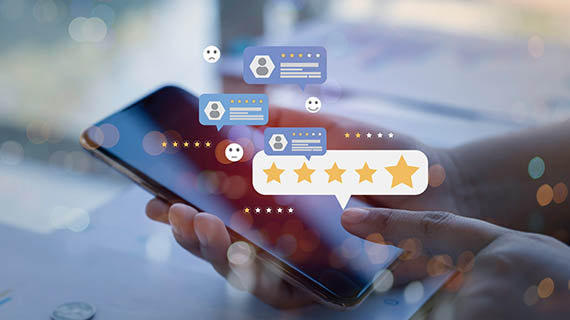
How to Transform Loyalty Into a Secret Weapon Featuring Forrester
For years we’ve discussed the desire of customers and brands to deliver individualized experiences reminiscent of stores in the 50s and 60s. Those of us who are older remember these experiences as kids in tow with our parents or grandparents. We looked forward to going to the butcher or bakery, being greeted by name. We browsed over conversations around families, what happened last week, and vacations we were planning. Our experience culminated with completing our order which was handed over along with what we call ‘surprise and delight’ today—a special something the merchant knew we’d appreciate and value—like a special cookie or kolacky from the bakery.
In a recent discussion with Cordial CRO Rachel Bergman, we discussed this phenomenon of how mass production tech led us to big box and mass advertising. Shortly after, both consumers and businesses yearned to get back to more personal interactions. Rachel reminisced about how, in the late 90s and early 2000s, building one-on-one relationships was a top priority for customer-centric marketers (and organizations). Fast-forward 20 years, it took brute force, but here we are having the same conversations. As consumers and marketers, we still desire to enjoy and deliver individualized experiences. Technology has advanced to the point where it’s not only possible but expected. Yet, most organizations still struggle.
To understand the gaps between expectations and execution, you may be asking one or more of the following questions.
According to Gartner analysts, very few organizations are delivering individualized experiences, with the majority struggling to get beyond the day-to-day blocking and tackling. Why is this? Analysts cite a myriad of reasons:
Consensus amongst key analysts points to a siloed structure that limits:
Siloed organizations tend to have many people and departments working toward the greater good of the organization and its’ customers, but because their applications and data aren’t connected, they’re all rowing in slightly different directions. Few things are as frustrating as having to repeat your personal or transaction details to multiple representatives. On the flip side, few things are as comforting and refreshing as having a representative address you by name and instantly know why you’re calling and what you’re looking for.
We’ve been discussing digital transformation daily for years. We all know we need it. Many of us have invested in it. And now, many of us don’t know what to do with what we have.
Pre-pandemic (2018) spend on digital transformation was $1.3 trillion, an estimated $900 billion wasted when initiatives didn’t meet the organization’s goals. We spent a lot following this vision, but we didn’t spend wisely. We acquired technologies we thought we needed but, even a few years later (and more DT spending), we still don’t know how best to leverage these technologies. For many, these technologies aren’t connected, so we’re missing out on the very synergies, efficiencies, and competitive advantages that drove us to purchase them in the first place. Many are redundant, while others are sitting idle.
Whatever your situation, you’re not alone.
There’s one tried-and-true option that’s been around since the late 80s, well actually much longer than that, that allows you to connect with your customers in a meaningful way. We’re talking about customer loyalty and its supporting technology.
Over the years, the term loyalty and the use of loyalty programs has developed a reputation—in some cases very good, in others very bad. Regardless of where you’re at on that pendulum, or how you feel about the coined term ‘loyalty’, read on. The truth is, loyalty is the secret weapon we’ve been ignoring that’ll enable and empower us all to deliver on decades of promised, yet under-delivered, individualized experiences.
Before we delve into loyalty, let’s explore what’s really behind expectations and experiences. Recently we had the pleasure of hosting a webinar with Forrester VP and Principal Analyst Brendan Witcher. Brendan spends his time studying the retail experience and customer behavior. At the core of his experience, he believes that all brand love is conditional. Therefore, brands need to understand the expectations or conditions customers have about our business. Brendan uses the example of going to a grocery store. If the store doesn’t have carts available, do you stay and shop? Of course not. Most brands have these basic conditions down pat.
What factors define a satisfactory experience? The answer is different for each of us. And customers have choices. That’s why organizations need a strategy to understand customers’ wants and needs at an individual level. This is how you take customer experience to the next level.
How do we move from being a company-obsessed organization to a customer-obsessed organization?
You do it with data. It’s all about how you use the data.
Less than 10% of companies have a 360-degree view of their customers, and only 5% are able to use a 360-degree view to systemically grow their businesses.
Source: Gartner
“Without data, you’re just another person with an opinion.”
W. Edwards Deming
Many of us are patting ourselves on the back because we have a lot of data and an analytics team at our fingertips. But Brendan challenges us to ask, “Are we using this data the right way?”
Brendan challenged us in this discussion around our use of data and made a very important distinction.
Data-driven organizations operate on opinions and hypotheses, using these to drive the outcomes of analytics. According to Witcher, most organizations he works with are data driven.
Data-led organizations use the data to determine the course. This means avoiding all preconceived notions about their customers and their business. They use data at the strategic level to make decisions after it’s presented and analyzed to determine which direction to go.
Examples of successful data-led organizations
At this point, you’re probably nodding your head, saying, “Yes, that makes sense. I’m on board to become data led.” You may also be scratching your head saying, “But how?”
The fastest way to get the data you need is by getting it directly from your customer. You do this through a loyalty strategy.
The fundamentals of a loyalty strategy are simple. There’s one basic principle—a committed value exchange. There are two major components to this exchange, the value and the commitment.
At its core, an organization offers value to its customer, typically in the form of goods or services. A purchase is a simple value exchange.
To get to a loyalty exchange, the organization needs to offer something above and beyond. This can be as simple as a discount on the first purchase or as meaningful as individualized experiences. Loyalty is the mechanism that organizations use to create added value or differentiation from their competition. Think of the airlines. Airline loyalty programs reward me for being loyal with early boarding and other benefits that make my life easier when traveling. An easier life is something I value.
A loyalty strategy involves a commitment by both the organization and the customer. The customer commits to identifying themselves (at every touchpoint) and sharing their data. The organization commits to being a good steward of that data (security, privacy, and use) and to deliver individualized experiences based on the provided data.
In the airline example, I commit to use my frequent flyer number every time I book or visit the airline’s website. I commit to this because the airline has made a commitment to me that after I’ve flown a certain number of times or attained a certain number of miles, I’ll get special benefits. This is a joint or mutual commitment.
When an organization offers a good (or individualized) reason for the customer to give their data, they share readily. The key, according to Witcher, is clearly communicating the customer value when you ask for the data.
Customers have no doubts about how Hudson Bay plans to use their information—and that it’s all focused on making sure they get products that are just right for them.
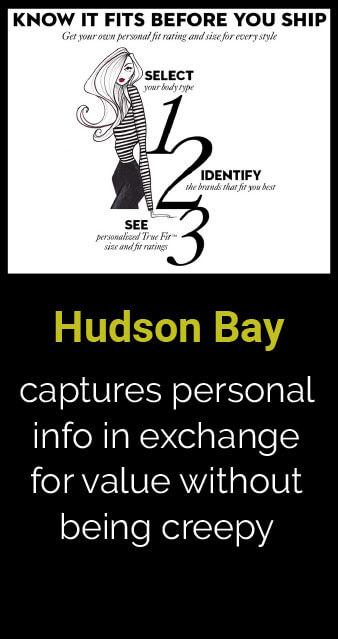
80% of people are willing to share personal information directly with a brand to receive personalized marketing. But only 16.7% are willing to share this type of data through third parties.
OneTrust First-party Data eBook

Stitch Fix is a great example of this. To get started with Stitch Fix, a customer needs to complete an extensive and very personal profile that takes just shy of 30 minutes to complete. Customers are happy to do this. Why? Because by sharing all this information, they know they’ll enjoy a better experience. They’ll get the products they want, in their favorite colors, in their just-right size. A meaningful value exchange is as simple as that. I provide my data. You provide me with an individualized experience.
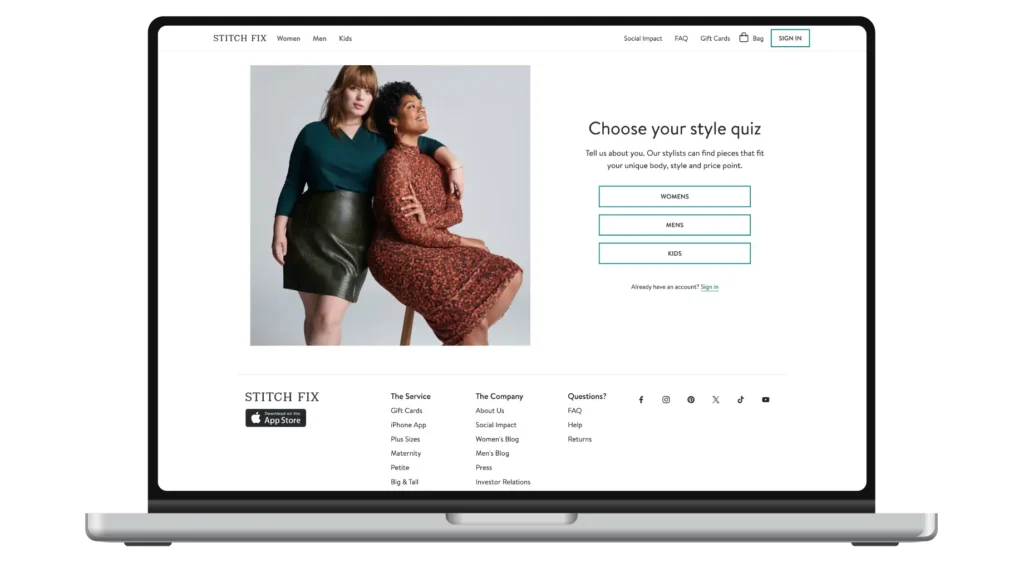
Now that we understand how the loyalty strategy can foundationally change your relationship with your customer, let’s get back to the data. To be a data-led organization, you need to collect more than the transactional data the airlines collect. You need to connect and communicate with customers at each touchpoint across their lifetime journey with your brand.
Here’s how.
We’ve all been through a customer journey mapping exercise. Now that you know that every great interaction starts with great data, try walking through it again, but this time with the mindset of being a data-led organization. What data points do you need to collect at each touchpoint to deliver the experiences your customers expect at each of these touchpoints? Loyalty gives you continual opportunities to engage with customers and get to know more about them with every interaction.

The move to becoming a data-led organization that delivers top-notch individualized experiences doesn’t happen overnight, it’s a process. The important thing is to start moving in that direction and build on your success.
Witcher advises organizations to consider these five key elements:

1. Customers are identified and treated as individuals using rich customer data.
You can’t use data to enrich experiences if you don’t have a system to capture it. Name, age and phone number won’t cut it today. The more you understand about a customer, the better the experience you can deliver. Look at capturing:
2. Customer data is assessed in real time and you can dynamically calculate intent.


3. Data flow is designed for a consistent and continuous customer journey.
Omnichannel is key here, so the conversation flows seamlessly from desktop to email to mobile.
4. Connected experiences enable richer and more relevant engagements. This is where siloed solutions break down.


5. Content intelligence is prioritized as much as customer intelligence. Share the value vision with content teams, so content aligns and supports your value strategy.
A loyalty strategy can help you move the needle on all of these elements, making it easy to know your customers on a deeper level and deliver individualized experiences dynamically at scale.
58% of customers report feeling as if they’re interacting with separate departments and not one single company.
Source: Deloitte
Here’s an example of how Annex Cloud clients are using loyalty as their secret weapon to deliver individualized customer experiences that build lasting bonds.
TaylorMade is a manufacturer of golf clubs and other golf gear. It was founded back in 1979 with a vision to create a new type of golf club—a wood not actually made out of wood. The organization was an innovator then and innovation is still a core pillar of everything they do. Today they’re a global brand with a strong commitment to their customer, individualized experiences and continued innovation. An example of how they individualize experiences—they offer customers the ability to personalize or customize their golf clubs.
As a manufacturer, they don’t see all of their customers—some purchase online but most purchase through their favorite golf pro or sporting goods store. That’s why they created their loyalty program—to engage with all customers wherever, however they’re purchasing.
TaylorMade launched their loyalty program a few years ago. Unlike many brands who add a loyalty program as a standalone initiative, siloed from the rest of the brand experience, TaylorMade integrated loyalty into everything they do.
They use the program in many ways to build engagement with their customers. Here are some of the things they’re doing:
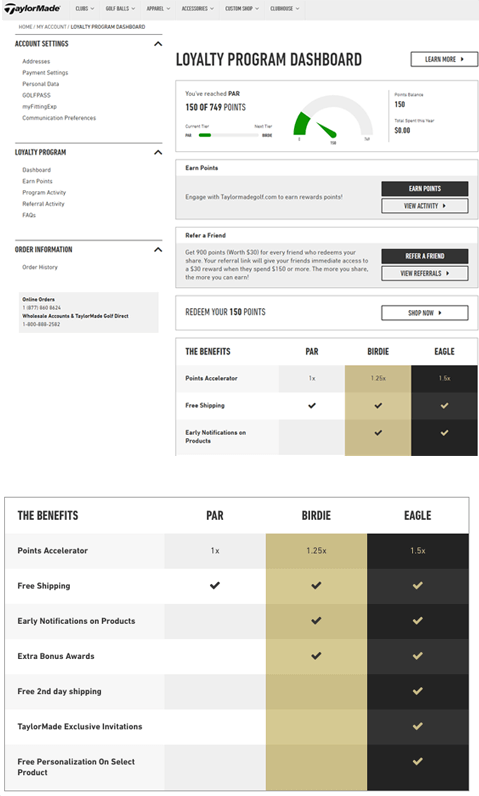
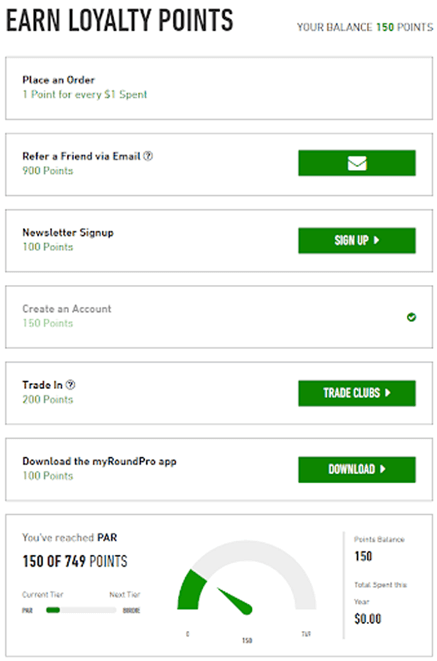
1. They created a virtual clubhouse where customers can come in, take tutorials, learn from the pros, podcasts, tips and much more. They use the loyalty program to build awareness and the clubhouse creates more engagement.
2. They use loyalty members for their R&D efforts. They do this in two ways: one is beta testing new products. Select top-tier members are able to test new clubs and provide feedback. Then, as these products come to market, these loyalty members get to pre-order, giving them the opportunity to get the hottest new products first.
3. TaylorMade also has myRoundPro app. If you think about TaylorMade and their purchase cycle, for most this isn’t a frequent purchase. So, how do you stay in touch with your customer in between purchases? The Clubhouse is one way. This app is another. Members earn points for downloading the app. The app keeps the member engaged and thinking about TaylorMade on the course, off the course when remembering their round, and even when they’re planning which course to play next.
4. Another way TaylorMade stays in touch with customers in between golf club purchases is they began selling golf balls. They don’t just sell them, they set up a subscription service. Now a TaylorMade product shows up at each member’s house on a regular basis.
5. TaylorMade also created a club buy-back back program. TaylorMade will buy back your clubs giving you a credit and points, giving you more reasons to choose TaylorMade for your next club purchase.
These are just a few ways TaylorMade is integrating the loyalty program and loyalty data into their customer experience. We encourage you to go to TaylorMade.com and engage in the experience.
Delivering individualized experiences isn’t just for B2C brands. Even before, but especially since the pandemic, we’re seeing people act with the same expectations whether buying as a consumer or for their business. The lines have blurred and the expectations have risen. We’ve seen many more B2B loyalty initiatives emerge over the last year and a half, each focused on collecting information to recognize customers in a very individualized fashion.
Our clients are enjoying great success because only the Annex Cloud Loyalty Experience Platform™ delivers what organizations need to bring individualized experiences to life at every touchpoint. Here are three key differentiators unique to only Annex Cloud:
1. Configurable, self-serve platform
Annex Cloud’s SaaS-based loyalty platform makes it quick and easy to deploy, update, change, test and pivot without re-coding or development.
2. Ever-growing capabilities
Annex Cloud’s 140-plus developers are continually innovating to ensure you have the latest loyalty technology and functionality. Get all the next-gen functionality you need to recognize and reward your customers, plus instant access to all new features and functionality as they’re released at no extra cost.
3. Technology-first approach
125-plus pre-defined integrations make it easy for our technology to be the heart of your tech stack, seamlessly collecting data and pushing it out to be leveraged at every touchpoint. Consider an ESP. The response data comes in. New communications are devised and the data is pushed back through automatically.
Annex Cloud’s partners make it easy to integrate loyalty into your customer interactions, rather than sending standalone loyalty communications. Here are just a few examples:

Imagine opening an email today, and opening it again next week, with automatically refreshed, up-to-date details. It doesn’t get more real time than that! Zembula makes it easy for brands to update email content—think abandoned cart items, available loyalty rewards, and more—at the time of open. Learn more in our Market Movers interview with Zembula CEO Robert Haydock.
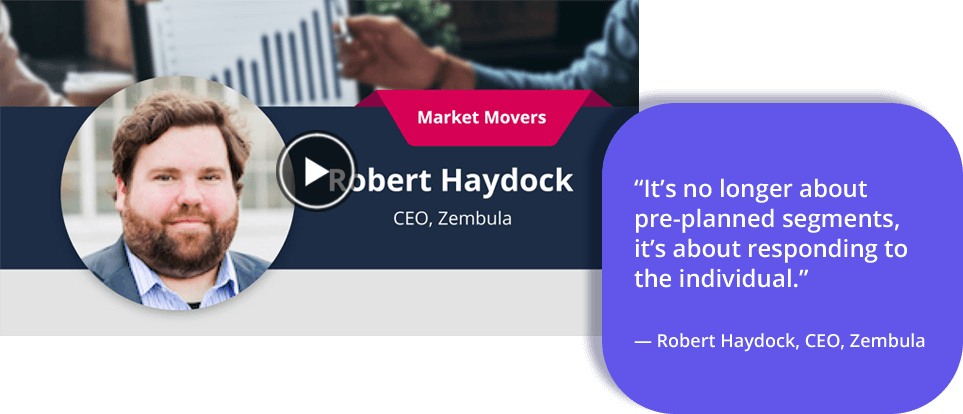
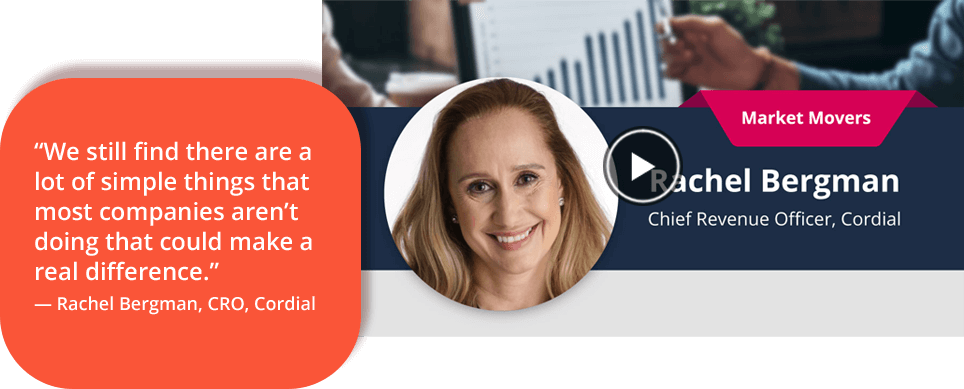
There are a lot of simple ways you can start leveraging loyalty to better understand your customers and, ultimately, better serve them. A great experience starts with having the right data that enables you to treat customers as individuals. The fact is customers enjoy talking about themselves and will tell you what they want from you—you simply have to give them plenty of opportunities to share who they are and what they expect. Loyalty provides the perfect framework for this two-way value exchange. The sooner you get started, the faster you’ll be on your way to building a solid base of loyal customers. Annex Cloud is here to meet you where you are and help you get where you want to grow.
Unleash your secret weapon, build lasting customer bonds.
Contact us to learn more.